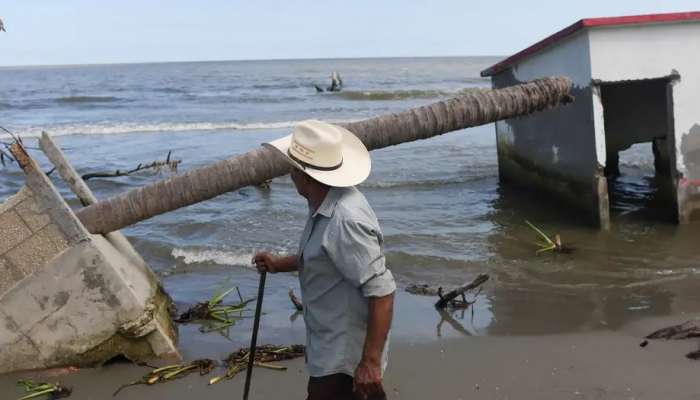
New York: “The ocean is overflowing,” warned UN secretary general Antonio Guterres at a recent visit to Tonga.
The archipelago in the South Pacific is one of several countries in the region that are severely and disproportionately threatened by sea level rise.
And while low-lying islands are particularly vulnerable, many coastal communities and cities worldwide are already struggling with more destructive floods and storms that endanger lives, jobs and crucial infrastructure.
How fast are sea levels rising?
Global sea levels have risen faster since the start of the 20th century than at any point in the last 3,000 years — and the pace is only accelerating.
Since records began in 1880, they have risen more than 20 cm(more than 8 inches), and this is getting faster with each decade. Global mean sea levels hit a record height in 2023, according to the World Meteorological Organisation.
And they are not rising equally around the globe due to ocean dynamics and the Earth’s unequal gravity field. In some areas of the southwestern Pacific, sea levels have risen close to twice the global rate since 1993.
How fast oceans will continue to rise depends on planetary heating.
If the world holds it below 1.5 degrees Celsius as set out in the Paris Agreement and hits net zero emissions by 2050, global sea levels are set to rise a further 38 cm by 2100. However, with current climate action setting us on a path to 2.7 degrees Celsius global warming by the end of the century this would lead to a further rise of 56 cm.
A few centimeters might not seem like much, but scientists estimate that every 2.5 cm of sea rise equates to 2.5 meters of lost beachfront and means that high tides and storm surges can reach even higher and further. Equally, for each centimeter of sea level rise, an extra 6 million people are estimated to be exposed to coastal flooding.
In extreme cases, scientists predict that human activity could cause sea levels to rise up to two meters by the end of the century.
What is causing them to rise?
Sea level is driven by global warming, caused by carbon dioxide, methane and other emissions released from the burning of fossil fuels for uses including energy, industry, and transport.
This is making the ocean heat up. Our seas have absorbed an estimated 90% of atmospheric warming over the past 50 years, and the pace of ocean heating has doubled in the last 20 years, rising three times faster than the global average in the southwest Pacific Sea. Ocean temperatures in 2023 were the hottest on record.
When water heats up, it grows in volume due to a process known as thermal expansion. Changes in land water storage — for example, through pumping groundwater — can also lead to a net change in ocean water volume.
However, one of the major sources of sea level rise is the melting of ice sheets and mountain glaciers due to increasing heat. An average of 150 billion tonnes of ice mass are lost yearly from Antarctica and 270 billion tonnes from Greenland.
Recent scientific reports have also raised concern about climate “tipping points,” where increases in temperatures beyond 1.5 degrees Celsius could trigger the irreversible collapse of the entire Greenland and West Antarctic ice sheets, with severe repercussions for sea levels.
Which parts of the world are most impacted?
Low-lying small islands, such as Fiji, the Maldives and Tuvalu, are facing some of the most critical threats from sea level rise — with even a moderate increase posing an existential danger.
However, sea level rises pose a global threat as nearly 40% of the world’s population lives near the coast and roughly 900 million in low-elevation zones.
Coastal cities and communities worldwide are already struggling with coastal erosion, agriculture and freshwater challenges due to saltwater intrusion and increasingly destructive flooding and storms.
According to a 2022 study, among the hardest hit places will be tropical regions, particularly in Asia, with Bangladesh, India, China particularly at risk. Some of the most vulnerable areas will be river deltas — broad areas where rivers meet the sea, often where port cities are located.
Megacities such as Cairo, Lagos, Los Angeles, Mumbai, Buenos Aires and London are all expected to face serious impacts.
What can be done to respond?
Ultimately, experts say the solution to preventing dramatic sea level rise lies in rapidly reducing emissions.
However, some degree of sea level rise is now inevitable — this is because even if the world stops emitting all greenhouse gases tomorrow, there is a time lag in the effect global heating has on ocean temperatures and ice and glacier melting.
Countries worldwide are employing a range of adaptation measures, from creating sea walls and storm surge barriers to improving drainage systems and flood resistant buildings.
Some of the adaptation measures are simple and nature based: from staving off coastal erosion by driving wooden stakes into Senegal’s beaches or regenerating mangrove forests in Cameroon.
For low lying small island states responses to sea level rise include moving entire villages to higher ground in Fiji, building floating cities in the Maldives and reclaiming land from the sea in Tuvalu.
Many developing regions need financial help to deal with sea level rise and other consequences being felt due to climate change, experts say.